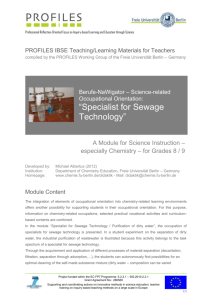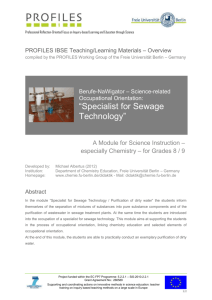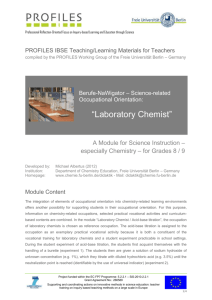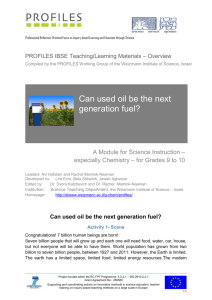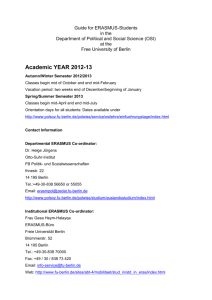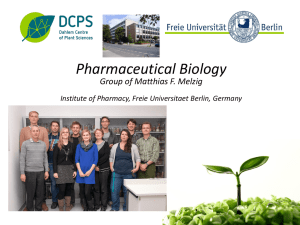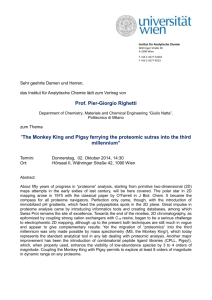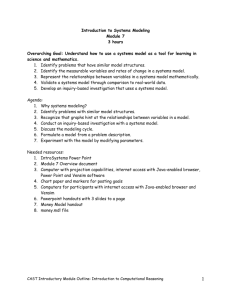WEIZMANN Plastics good or bad
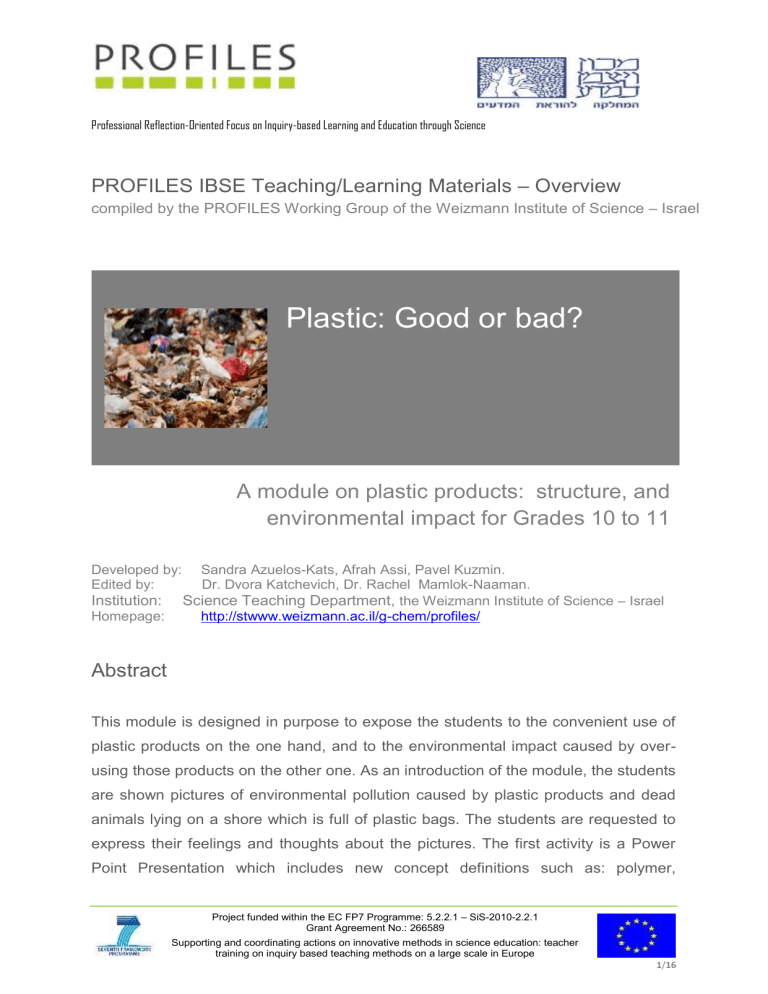
Professional Reflection-Oriented Focus on Inquiry-based Learning and Education through Science
PROFILES IBSE Teaching/Learning Materials – Overview
compiled by the PROFILES Working Group of the Weizmann Institute of Science – Israel
Plastic: Good or bad?
A module on plastic products: structure, and environmental impact for Grades 10 to 11
Developed by: Sandra Azuelos-Kats, Afrah Assi, Pavel Kuzmin.
Edited by: Dr. Dvora Katchevich, Dr. Rachel Mamlok-Naaman.
Institution: Science Teaching Department, the Weizmann Institute of Science – Israel
Homepage: http://stwww.weizmann.ac.il/g-chem/profiles/
Abstract
This module is designed in purpose to expose the students to the convenient use of plastic products on the one hand, and to the environmental impact caused by overusing those products on the other one. As an introduction of the module, the students are shown pictures of environmental pollution caused by plastic products and dead animals lying on a shore which is full of plastic bags. The students are requested to express their feelings and thoughts about the pictures. The first activity is a Power
Point Presentation which includes new concept definitions such as: polymer,
Project funded within the EC FP7 Programme: 5.2.2.1 – SiS-2010-2.2.1
Grant Agreement No.: 266589
Supporting and coordinating actions on innovative methods in science education: teacher training on inquiry based teaching methods on a large scale in Europe
1/16
Professional Reflection-Oriented Focus on Inquiry-based Learning and Education through Science repeating unit, recycling, and exhaustible polymers. The second activity is reading a text about a turtle which almost dies as a result of eating an inedible plastic bag thrown on the shore. The students answer the questions which follow the text. On the third activity the students carry out two experiments: production of Nylon and testing the water solubility of polyethylene bag and polyvinyl alcohol bag. The students are required to provide a micro explanation for the results: P.V.A. is soluble in water, in contrast to the P.E. which is insoluble in water. On the 4th activity the students work into groups using a thinking tool. They are supposed to suggest alternative ways which might reduce the negative influence resulted from the accumulation of plastic waste such as: taxes on plastic production, minimizing the usage, recycling, using green environmentally friendly products. Furthermore, they are expected to make a decision and choose the alternative way which they prefer for achieving the target. Finally, on the 5th last activity, they present their decision and justified reasons.
We, the developers of this module, wish that this module will develop the sense of responsibility of chemistry students to the environment, by increasing their awareness to the environmental impact of imperishable polymers and by exposing them to other possibilities such as recycling and alternative exhaustible materials.
They might be our ambassadors on their houses.
Developed by: Sabine Streller, Claudia Benedict, Claus Bolte (2007)
Institution: Department of Chemistry Education, Freie Universität Berlin – Germany
Homepage: www.chemie.fu-berlin.de/didaktik - Mail: didaktik@chemie.fu-berlin.de
Adapted by: FUB-PROFILES Working Group (2011) www.profiles-projects.eu
Overview – 2/16
Professional Reflection-Oriented Focus on Inquiry-based Learning and Education through Science
Subject: Science and/or Chemistry
Grade level: 10 th to 11 th grade
Curriculum content: Polymers, repeating unit, exhaustible polymers, solubility of polymers in water.
Kind of activity: Enquiring, explaining, laboratory work, group activities etc.
Anticipated time: 4-5 lessons of 45 minutes
Overall Objectives/ Skills:
During this module, students are expected:
to know and understand new concepts , such as:
Polymer, structure of polymers, repeating unit.
plastic
exhaustible polymers
to develop their competencies on :
making a decision
critical thinking
working on a group
Expressing their thoughts and feelings orally.
Reading comprehension of texts.
to be exposed to the relevance of chemistry ,for example:
Various uses of plastics on our daily life.
The negative influence caused by the un-perishable plastic waste on the environment.
to carry out experiments and :
Explain the results based on the microscopic structure.
Articulate a research question.
Attached files
1. Student activities
2. Teaching guide
Hyprerlink missing
Describes the scenario in more detail and the tasks the students should carry out
Suggests a teaching approach
Developed by: Sabine Streller, Claudia Benedict, Claus Bolte (2007)
Institution: Department of Chemistry Education, Freie Universität Berlin – Germany
Homepage: www.chemie.fu-berlin.de/didaktik - Mail: didaktik@chemie.fu-berlin.de
Adapted by: FUB-PROFILES Working Group (2011) www.profiles-projects.eu
Overview – 3/16
Professional Reflection-Oriented Focus on Inquiry-based Learning and Education through Science
Acknowledgement:
The idea for the experiment of this module was taken from the Teaching-Learning
Materials Tool compiled by the PARSEL Consortium (namly by Streller, Benedict, &
Bolte, 2007) as part of the EC FP6 funded PARSEL Project (SAS6-CT-2006-042922-
PARSEL) and adapted by the FUB-PROFILES Working Group – Member of the
PROFILES Consortium. For further information see: www.parsel.eu
.
Developed by: Sabine Streller, Claudia Benedict, Claus Bolte (2007)
Institution: Department of Chemistry Education, Freie Universität Berlin – Germany
Homepage: www.chemie.fu-berlin.de/didaktik - Mail: didaktik@chemie.fu-berlin.de
Adapted by: FUB-PROFILES Working Group (2011) www.profiles-projects.eu
Overview – 4/16
Professional Reflection-Oriented Focus on Inquiry-based Learning and Education through Science
PROFILES IBSE Teaching/Learning Materials – Overview compiled by the PROFILES Working Group of the Weizmann Institute of Science – Israel
Abstract
Developed by: Sandra Azuelos-Kats, Afrah Assi, Pavel Kuzmin.
Edited by: Dr. Dvora Katchevich, Dr. Rachel Mamlok-Naaman.
Institution: Science Teaching Department, the Weizmann Institute of Science – Israel
Homepage: http://stwww.weizmann.ac.il/g-chem/profiles/
Plastics: Good or bad?
Opening: Picture interpretation
Split into groups of 4 students, get a picture from the teacher, and answer the following questions :
A. What is your impression of the picture?
B. What do you feel when you look at the picture?
C. Does it bother you to see the picture? If so,why? If not, why?
D. What would you like to do after you've seen the picture? Note anything that you can think of
Activity number (1): P.P.P.
Watch the attached P.P.P (Power Point Presentation)
Activity number (2): Reading a story
Read the story " A sad story that happened on the beach". Dr. Jeremy Klein and answer the questions presented below.
One Saturday, when Roy and his father were walking on the beach on the Hasharon coast,
Roy noticed something lying a few dozen meters in front of them. Roy started running towards to the unidentified thing, but his father stopped him. "Slowly," said his father, "You never know what we will encounter." They approached cautiously toward the dark mass and
Roy suddenly shouted: "This is a " sea turtle". It looked completely exhausted. When the turtle saw them, he tried to move a little, but barely could do it. Roy's father called the police, and they gave him the emergency telephone number of the Turtle Rescue Center - in
Mikhmoret. After half an hour, during which Roy and his father were asked to spray seawater
Developed by: Sabine Streller, Claudia Benedict, Claus Bolte (2007)
Institution: Department of Chemistry Education, Freie Universität Berlin – Germany
Homepage: www.chemie.fu-berlin.de/didaktik - Mail: didaktik@chemie.fu-berlin.de
Adapted by: FUB-PROFILES Working Group (2011) www.profiles-projects.eu
Overview – 5/16
Professional Reflection-Oriented Focus on Inquiry-based Learning and Education through Science on the turtle, two guys came from the center. These were the center's director Yaniv and the veterinarian Gil. With several people who gathered on the beach they moved the turtle into a large car and drove him to the Turtle Rescue Center. The veterinarian Gil infused fluid infusion into the turtle, in order to try and save him. He claimed:. "This is a Gladi sea-turtle, one of the three most common turtles in the Mediterranean Sea.
He is exhausted and has trouble breathing. Apparently he was laying on the beach a few hours before we found him, and certainly did not eat for days, "said Yaniv." Can we save him? ", Roy asked anxiously.
"The truth is that it looks very bad, but we will try," said Gil.
Gil wore an Oxygen mask on the face of the turtle and said: "According to my experience, I think that the turtle is choking from something that he swallowed. We will have no other way but conduct a surgery, which may take several hours. Therefore, you should go back home and we will update you about the situation. During the surgery, Gil removed from the turtle stomach a large bag of thick plastic.
As promised, he called Roy and informed him that the surgery was successful. "You would not believe if you see what we got from the stomach of the turtle. When he will recover you will be able to visit him". Roy was happy. A few days later Roy came to the rescue center in
Michmoret to visit the place. He hugged Gil and Yaniv and thanked them very much: "We need to thank you for the attention. You did the right thing. Please continue to keep an eye on the beach. And most importantly, Roy, tell the class what happened. It is important that everyone will learn that throwing waste into the sea must stop ". After a few weeks he invited
Roy and his father to watch the release of the turtle back to the sea.
Questions for discussion:
A. Name the story you just read. Why did you choose this name?
B. Who is responsible for the damage of the sea turtle?
C. Why do you think it was necessary to establish in Michmoreta Turtle Rescue Center?
D. What must we do to in order to prevent damage to living creatures and to the shores of our country?
Activity number (3): Carrying out two experiments:
•
Experiment (A) : Nylon production
• Experiment (B) : Water solubility test :
Poly-vinyl-alcohol
Polyethylene
Experiment (A) - Nylon production
Materials and equipment:
1. 4cc of 1, 6 hexanediamine solution.
2.
3.
4 cc of sebacoyl chloride solution
Tweezers
4.
5.
Glass rod
Chemical glass
Performing the experiment:
1. Replace the 4cc of 1, 6 hexanediamine solution in the bottom of the chemical glass.
2.
3.
Add slowly 4 cc of sebacoyl chloride solution to the chemical glass.
Use the tweezers and grope the layer. Pull it out and roll it on the glass rod.
Developed by: Sabine Streller, Claudia Benedict, Claus Bolte (2007)
Institution: Department of Chemistry Education, Freie Universität Berlin – Germany
Homepage: www.chemie.fu-berlin.de/didaktik - Mail: didaktik@chemie.fu-berlin.de
Adapted by: FUB-PROFILES Working Group (2011) www.profiles-projects.eu
Overview – 6/16
Professional Reflection-Oriented Focus on Inquiry-based Learning and Education through Science
Write down your observations.
Watch the attached link below: http://www.youtube.com/watch?v=c7ihpZhCj6k
Experiment (B) - water solubility test.
Materials and equipment:
1.
2.
3.
4.
Polyethylene bags P.E. poly- vinyl-alcohol PVA
Chemical glasses
A glass rod
Water 5.
Performing the experiment:
1. Put a piece of polyethylene bag 10x10cm in 100ml of water. Mix with glass stick.
2. put a piece of poly-vinyl-alcohol 10x10cm in a 100ml of water. Mix with a glass stick.
Answer the following questions:
1. Record your observations. (Macroscopic level explanation)
This is the structure of the repeating unit of the two polymers:
P.E. P.V.A
2.
3.
Explaine the experimental results based on the microscopic structure.
Write five questions that arise after the experiment.
4. Formulate research question concerning the experiment, the dependence between two variables.
5. Poly-vinyl-alcohol (PVA) is used as collection Bags of dirty laundry in hospitals. They place the bag containing dirty laundry into the washing machine. How do you explain this use?
Activity number (4): Making a decision using a thinking tool.
Dimensions criterions Alternative a
Banning the production Alternative b
Taxes on productions Alternative c
Increasing the recycling Alternative d
Reducing the usage Alternative e
? environment green areas less waste sites livelihood gain
Number of mills
Developed by: Sabine Streller, Claudia Benedict, Claus Bolte (2007)
Institution: Department of Chemistry Education, Freie Universität Berlin – Germany
Homepage: www.chemie.fu-berlin.de/didaktik - Mail: didaktik@chemie.fu-berlin.de
Adapted by: FUB-PROFILES Working Group (2011) www.profiles-projects.eu
Overview – 7/16
Professional Reflection-Oriented Focus on Inquiry-based Learning and Education through Science
?
Number of workers loss
Well-being Presence of disposable kitchen utensils on market
Low prices loss health
?
Fill in the missing places: gain / loss. You may add alternatives, dimensions and criterions.
Which alternative way you prefer to choose in order to reduce the plastic waste.
•
•
Activity number (5): Presentations
• Display the text which you have received.
•
Introduce the thinking tools that you have received.
Present the way in which your group came to the decision about ......
Explain how the thinking tools helped you make the decision.
Evaluation:
The evaluation of the students will be based on the following criteria.
Decision making: ach student will receive only one decision tool, so that he / she will be able to answer only two section of the assessment and the third would be irrelevant .
Scoring
10%
Percent Criteria
Questions raised by students
Dimension
Picture interpretation 10%
20% Answers to the questions Text reading 20%
10% Performing an experiment according to the instructions in a clean and tidy way Experiment 30%
10% Teamwork
10% Answers to the question / questions( Micro, Macro, Symbol)
10% Number of alternatives offered to resolve a problem
Decisionmaking 20%
10% Number of dimensions and criteria taken into account
10% Range of effects taken into account
10% Participation of all team members roles in the presentation
Presentation 20%
10% Articulating on the decision
Acknowledgement:
Developed by: Sabine Streller, Claudia Benedict, Claus Bolte (2007)
Institution: Department of Chemistry Education, Freie Universität Berlin – Germany
Homepage: www.chemie.fu-berlin.de/didaktik - Mail: didaktik@chemie.fu-berlin.de
Adapted by: FUB-PROFILES Working Group (2011) www.profiles-projects.eu
Overview – 8/16
Professional Reflection-Oriented Focus on Inquiry-based Learning and Education through Science
The idea for the experiment of this module was taken from the Teaching-Learning Materials
Tool compiled by the PARSEL Consortium (namly by Streller, Benedict, & Bolte, 2007) as part of the EC FP6 funded PARSEL Project (SAS6-CT-2006-042922-PARSEL) and adapted by the FUB-PROFILES Working Group – Member of the PROFILES Consortium. For further information see: www.parsel.eu.
Developed by: Sabine Streller, Claudia Benedict, Claus Bolte (2007)
Institution: Department of Chemistry Education, Freie Universität Berlin – Germany
Homepage: www.chemie.fu-berlin.de/didaktik - Mail: didaktik@chemie.fu-berlin.de
Adapted by: FUB-PROFILES Working Group (2011) www.profiles-projects.eu
Overview – 9/16
Professional Reflection-Oriented Focus on Inquiry-based Learning and Education through Science
PROFILES IBSE Teaching/Learning Materials
– Overview
Compiled by the PROFILES Working Group of the Weizmann Institute of Science – Israel
Plastic: Good or bad?
A module on plastic products: structure, and environmental impact for Grades 10 to 11
Developed by: Sandra Azuelos-Kats, Afrah Assi, Pavel Kuzmin.
Edited by: Dr. Dvora Katchevich, Dr. Rachel Mamlok-Naaman.
Institution: Science Teaching Department, the Weizmann Institute of Science
– Israel
Homepage: http://stwww.weizmann.ac.il/g-chem/profiles/
Developed by: Sabine Streller, Claudia Benedict, Claus Bolte (2007)
Institution: Department of Chemistry Education, Freie Universität Berlin – Germany
Homepage: www.chemie.fu-berlin.de/didaktik - Mail: didaktik@chemie.fu-berlin.de
Adapted by: FUB-PROFILES Working Group (2011) www.profiles-projects.eu
Overview – 10/16
Professional Reflection-Oriented Focus on Inquiry-based Learning and Education through Science
Summary of activities
Activity 1- world energy crisis
Introduction: Pictures interpretation.
Watching a P.P.P. (Power point presentation)
Reading texts and answering questions.
Carrying out experiments:
Production of nylon.
Testing the solubility of P.V.A. and P.E. in water.
Thinking tools for making a decision.
Presentations: Each group should present its text, attitudes and explanations.
Timetable:
Lesson number
1
2
3
4
5 activity
Picture interpretation
P.P.P.
Reading texts
Experiments
Thinning tool presentation
Anticipated time
(minutes)
20
20
45
45
45
45
Activity number (1):
Picture interpretation
– the students are divided into groups of (4) students .Each group receives one picture and is required to answer the questions that follows.
Power point presentation (P.P.P.) – This activity may be performed in two possible ways:
By the teacher with the whole class.
Into groups in a computer class.
Activity number (2): Reading texts
The students are divided into groups of (4) students .Each group receives one text and is required to answer the questions that follows.
Developed by: Sabine Streller, Claudia Benedict, Claus Bolte (2007)
Institution: Department of Chemistry Education, Freie Universität Berlin – Germany
Homepage: www.chemie.fu-berlin.de/didaktik - Mail: didaktik@chemie.fu-berlin.de
Adapted by: FUB-PROFILES Working Group (2011) www.profiles-projects.eu
Overview – 11/16
Professional Reflection-Oriented Focus on Inquiry-based Learning and Education through Science
Activity number (3): Carrying out experiments
Each group carries out two experiments:
Production of Nylon.
Testing the water solubility of :
Polyethylene.(P.E.)
Polyvinyl alcohol. (P.V.A.)
Activity number (4): Making a decision using a thinking tool.
Each group is required to use a thinking tool (gain
– loss - analyzing), in order to make a decision.
Activity number (5): presentation
Each group represents its decision and its justified reasons.
Notes for the teacher:
This Module may help demonstrating the relevance of chemistry and plastic to our daily life.
For example:
Polyvinyl alcohol bags are used as collecting laundry bags in hospitals. This polymer is soluble in water.
Bottles which are collected for recycling are used to produce fibers.
You may elaborate the subject of functional groups: carboxylic acid, alcohol and side groups in the P.V.A..
You can expand on the solubility of P.V.A. and P.E. :
hydrophilic groups, hydrophobic groups, you can have students draw the hydrogen bonds between one repeating unit of P.V.A. and two water molecules.
Research questions that students should formulate after the experiments in activity number (3):
What is the relation between the polymer solubility in water and the temperature of the water?
What is the relation between the polymer solubility in water and the polymer's structure?
Developed by: Sabine Streller, Claudia Benedict, Claus Bolte (2007)
Institution: Department of Chemistry Education, Freie Universität Berlin – Germany
Homepage: www.chemie.fu-berlin.de/didaktik - Mail: didaktik@chemie.fu-berlin.de
Adapted by: FUB-PROFILES Working Group (2011) www.profiles-projects.eu
Overview – 12/16
Professional Reflection-Oriented Focus on Inquiry-based Learning and Education through Science
Scientific background regarding the module:
Student's scientific background: The power point presentation.
Teacher's scientific background :
The production process of poly-vinyl-alcohol bags:
.
The polymer solubility in water:
Developed by: Sabine Streller, Claudia Benedict, Claus Bolte (2007)
Institution: Department of Chemistry Education, Freie Universität Berlin – Germany
Homepage: www.chemie.fu-berlin.de/didaktik - Mail: didaktik@chemie.fu-berlin.de
Adapted by: FUB-PROFILES Working Group (2011) www.profiles-projects.eu
Overview – 13/16
Professional Reflection-Oriented Focus on Inquiry-based Learning and Education through Science
A student questionnaire
Answer the questions below .Choose an answer from 1-4.
1. Not at all
2. A little
3. Much
4. Very much
Questions
1 Did you know that most of the plastic products are inexhaustible?
2 Did the module expand your knowledge?
3 Did you expect that plastic bags might be soluble in water?
4 Did the module cause you to think differently about your plastic usage habits?
5 Were the experiments interesting for you?
1 2 3 4
6 Was the text interesting for you?
7 Do you think that you might change your habits on using plastic products after this module?
8 Was it easy for you to make a decision at the end of the module?
9 Do you think that there is a lack of awareness regarding overusing plastic products?
10 Did you agree with your classmates on the decision you made?
1. Which parts of the module you liked the most?
2. Which parts of the module helped you to make a decision?
3. How do you suggest we may increase the awareness of people about the accumulation of plastic waste?
Developed by: Sabine Streller, Claudia Benedict, Claus Bolte (2007)
Institution: Department of Chemistry Education, Freie Universität Berlin – Germany
Homepage: www.chemie.fu-berlin.de/didaktik - Mail: didaktik@chemie.fu-berlin.de
Adapted by: FUB-PROFILES Working Group (2011) www.profiles-projects.eu
Overview – 14/16
Professional Reflection-Oriented Focus on Inquiry-based Learning and Education through Science
A teacher questionnaire
Answer the questions below .Choose an answer from 1-4 .
1. Not at all
2. A little
3. Much
4. Very much
Questions
1 Was the module taught for 4-5 .lessons?
Did the experiment contribute to achieving the goals of the
2 module?
3
4
Didthe discussion of the goals contribute to improving the module?
Did the presentation contribute to achieving the goals of the module?
1 2 3 4
5 Didthe students have found serious reading texts?
6 Do you think that the length of the module is reasonable?
7 Was it easy for students to cope with the decision tool?
Were the students serious and interested in performing the
8 experiments?
9 Did the module achieve its goals?
1. Do you think that the students were able to develop a negative attitude regarding the use of excessive plastic ?
2. Do you think that the students were able to take a stand and make a decision on "How can we minimize plastic waste
?"
3. If you were forced to shorten - what parts of the module would you skip
?
4. What changes would you make in the module
?
Developed by: Sabine Streller, Claudia Benedict, Claus Bolte (2007)
Institution: Department of Chemistry Education, Freie Universität Berlin – Germany
Homepage: www.chemie.fu-berlin.de/didaktik - Mail: didaktik@chemie.fu-berlin.de
Adapted by: FUB-PROFILES Working Group (2011) www.profiles-projects.eu
Overview – 15/16
Professional Reflection-Oriented Focus on Inquiry-based Learning and Education through Science
Bibliography :
www.orianit.edu-negev.gov.il/kayamut/cp/.../michzurlearn.htmclickit.ort.org.il/files/upl/109142845/496255934.doc www.matar.ac.il/EndOfPlastik.asp
http://www.matar.ac.il
/
http://pslc.ws/macrog/pva.htm
www.recycling.co.il/11/www.yerookim.co.il/article.aspx?id=187
www.ynet.co.il/articles/0,7340,L-3175518,00.html
lib.cet.ac.il/pages/item.asp?item=2699
www.adamteva.org.il
www.recycling.co.il/01 /
-
Developed by: Sabine Streller, Claudia Benedict, Claus Bolte (2007)
Institution: Department of Chemistry Education, Freie Universität Berlin – Germany
Homepage: www.chemie.fu-berlin.de/didaktik - Mail: didaktik@chemie.fu-berlin.de
Adapted by: FUB-PROFILES Working Group (2011) www.profiles-projects.eu
Overview – 16/16
